Input interpretation

methyl carbonate
Chemical names and formulas
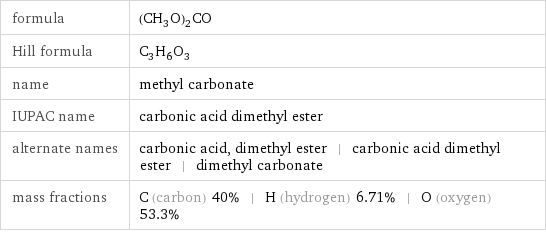
formula | (CH_3O)_2CO Hill formula | C_3H_6O_3 name | methyl carbonate IUPAC name | carbonic acid dimethyl ester alternate names | carbonic acid, dimethyl ester | carbonic acid dimethyl ester | dimethyl carbonate mass fractions | C (carbon) 40% | H (hydrogen) 6.71% | O (oxygen) 53.3%
Lewis structure
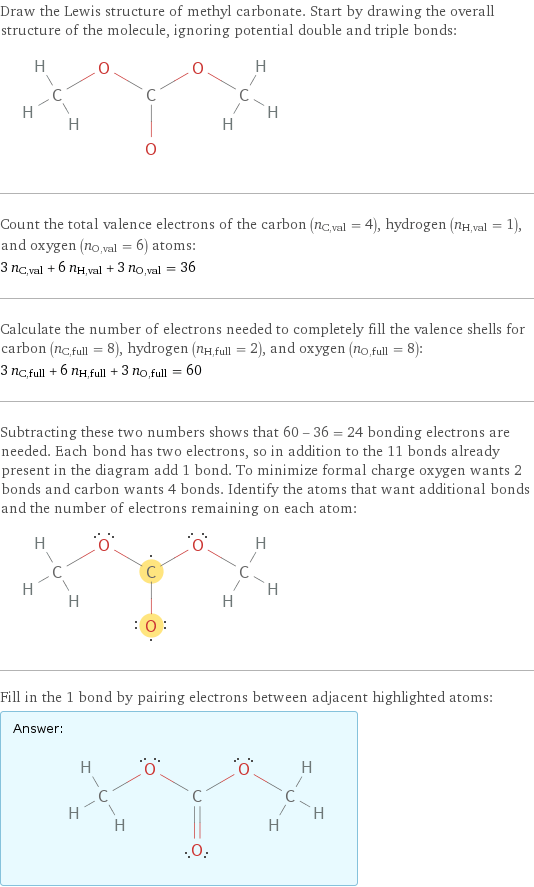
Draw the Lewis structure of methyl carbonate. Start by drawing the overall structure of the molecule, ignoring potential double and triple bonds: Count the total valence electrons of the carbon (n_C, val = 4), hydrogen (n_H, val = 1), and oxygen (n_O, val = 6) atoms: 3 n_C, val + 6 n_H, val + 3 n_O, val = 36 Calculate the number of electrons needed to completely fill the valence shells for carbon (n_C, full = 8), hydrogen (n_H, full = 2), and oxygen (n_O, full = 8): 3 n_C, full + 6 n_H, full + 3 n_O, full = 60 Subtracting these two numbers shows that 60 - 36 = 24 bonding electrons are needed. Each bond has two electrons, so in addition to the 11 bonds already present in the diagram add 1 bond. To minimize formal charge oxygen wants 2 bonds and carbon wants 4 bonds. Identify the atoms that want additional bonds and the number of electrons remaining on each atom: Fill in the 1 bond by pairing electrons between adjacent highlighted atoms: Answer: | |
3D structure
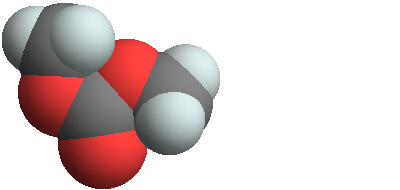
3D structure
Basic properties
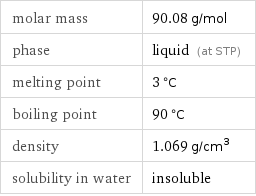
molar mass | 90.08 g/mol phase | liquid (at STP) melting point | 3 °C boiling point | 90 °C density | 1.069 g/cm^3 solubility in water | insoluble
Units

Liquid properties (at STP)
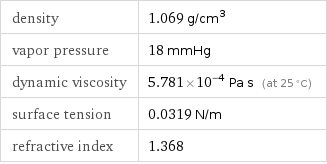
density | 1.069 g/cm^3 vapor pressure | 18 mmHg dynamic viscosity | 5.781×10^-4 Pa s (at 25 °C) surface tension | 0.0319 N/m refractive index | 1.368
Units

Thermodynamic properties

molar heat of vaporization | 37.7 kJ/mol specific heat of vaporization | 0.419 kJ/g molar heat of combustion | 1429 kJ/mol specific heat of combustion | 15.86 kJ/g thermal conductivity | 0.1696 W/(m K) critical temperature | 557 K critical pressure | 4.8 MPa (at STP)
Chemical identifiers

CAS number | 616-38-6 Beilstein number | 635821 PubChem CID number | 12021 PubChem SID number | 24873943 SMILES identifier | COC(=O)OC InChI identifier | InChI=1/C3H6O3/c1-5-3(4)6-2/h1-2H3 RTECS number | FG0450000 MDL number | MFCD00008420
NFPA label

NFPA label
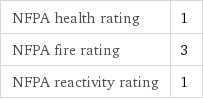
NFPA health rating | 1 NFPA fire rating | 3 NFPA reactivity rating | 1
Safety properties
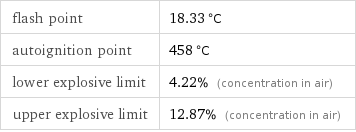
flash point | 18.33 °C autoignition point | 458 °C lower explosive limit | 4.22% (concentration in air) upper explosive limit | 12.87% (concentration in air)

DOT hazard class | 3 DOT numbers | 1161
Toxicity properties

RTECS classes | other